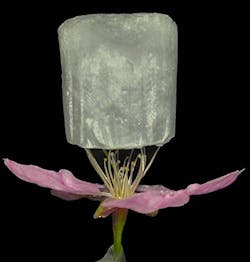Researchers Tackle Carbon Capture Challenges
[pullquote]
Two research breakthroughs, one in Sweden, the other in Switzerland, have thrown new light on two outstanding challenges to carbon capture technology: how to overcome the shortcomings of zeolites; and how to pinpoint the most appropriate metal organic frameworks (MOFs) from a cast of hundreds of thousands.
Scientists at Chalmers University of Technology, Gothenburg, and Stockholm University, both in Sweden, have developed a bio-based hybrid foam laced with zeolites that can absorb high levels of carbon dioxide.
Zeolites’ larger particle size typically makes them tricky to work with and, thus, has limited their use for carbon capture. However, the researchers addressed these problems by working with smaller (<200-nm) particles combined with a meso- and macroporous support material based on a foam of gelatin and nanocellulose. This achieved up to 90% by weight of zeolite content, giving the material better ability to selectively adsorb carbon dioxide while still providing a very open pore structure that enables high gas flows.
“What surprised us most was that it was possible to fill the foam with such a high proportion of zeolites. When we reached 90% by weight, we realized we had achieved something exceptional. We see our results as a very interesting piece of the puzzle in the search for a solution to the complex challenge of reducing the amount of carbon dioxide in the Earth’s atmosphere quickly enough to meet climate goals,” says Walter Rosas Arbelaez, a PhD student at Chalmers’ department of chemistry and chemical engineering and one of the researchers behind the study published in ACS Applied Materials & Interfaces.
Figure 1. A sample of the new material resting on a flower, demonstrating its extremely low weight. Source: Luis Valencia.
“This research fits well with the ongoing developments within CCS [carbon capture and storage] and CCU [carbon capture and utilization] technology, as a sustainable alternative with great potential. In addition to bio-based materials being more environmentally friendly, the material is a solid — once the carbon dioxide has been captured, it is therefore easier and more efficient to separate it than from the liquid amine solutions,” says Anders Palmqvist, research leader at Chalmers.
Amines used in CCS technology have several problems, such as the volume required, their corrosive nature, and the amount of energy needed to separate the captured carbon dioxide from the amine solution, points out Palmqvist. The new material avoids all these issues and could well be used in easy-to-manufacture filter applications, he suggests.
Meanwhile, the Swiss work focuses on overcoming the problem that materials good at capturing carbon dioxide tend also to be good at capturing water — making them useless with wet flue gases.
Chemical engineers at the Swiss Federal Institute of Techonology Laussane (École Polytechnique Fédérale de Lausanne, EPFL) have designed a material that can capture carbon dioxide from wet flue gases better than current commercial materials. They describe their work in a recent article in Nature.
Research lead Berend Smit, a professor in the molecular simulation laboratory at EPFL, calls the work a breakthrough for computational materials design because the scientists used an out-of-the-box approach more typically applied in drug discovery — they treated carbon dioxide in the same way that pharmaceutical companies treat a disease.
Pharmaceutical companies typically test millions of molecules to find ones that bind to a target protein related to the disease in question. The molecules that bind are then analyzed to detect any common structural properties that will form the basis for designing and synthesizing new drug molecules.
The EPFL scientists computer-generated 325,000 materials whose common motif is the ability to bind carbon dioxide. All the materials are MOFs that have been the focus of Smit’s research for many years.
The team then looked for structural similarities among the MOFs that preferentially bind carbon dioxide over water. Adding parameters of selectivity further narrowed the subclass. Finally, the researchers’ MOF-generation algorithm settled on 35 materials that show better carbon dioxide capturing ability from wet flue-gas than current commercially available materials.
The Research Centre for Carbon Solutions at Heriot-Watt University, Edinburgh, Scotland; U.S. Department of Energy Center for Gas Separations Relevant to Clean Energy Technologies, Berkeley, Calif.; and the National Energy Research Scientific Computing Center, also in Berkeley, confirmed their findings.
“What makes this work stand out is that we were also able to synthesize these materials,” says Smit. “That allowed us to work with our colleagues to show that the MOFs actually adsorb carbon dioxide and not water, actually test them for carbon capture, and compare them with existing commercial materials.”
Seán Ottewell is Chemical Processing's Editor at Large. You can email him at [email protected].


